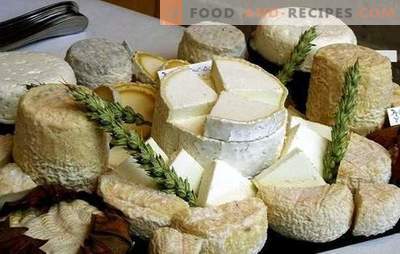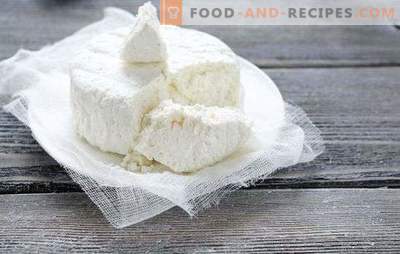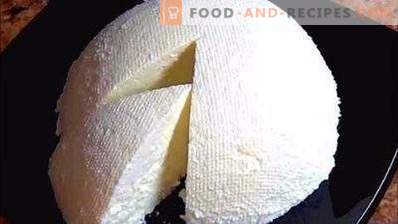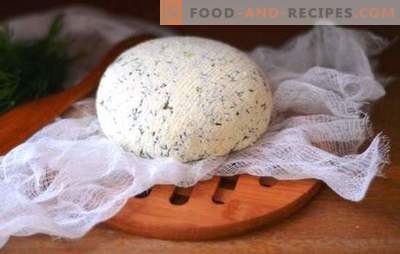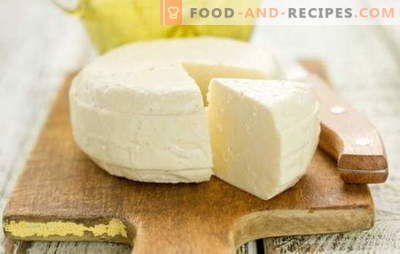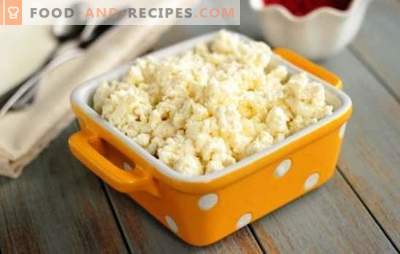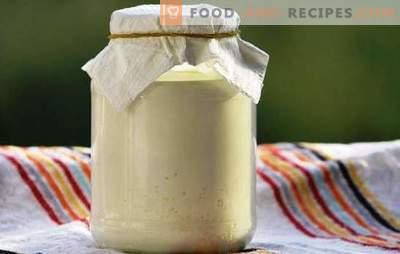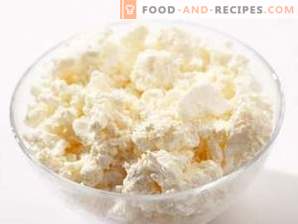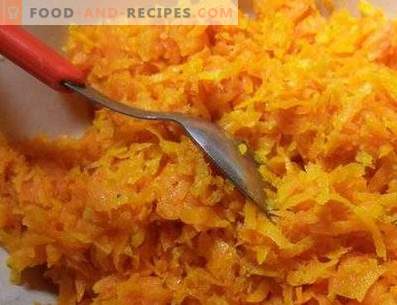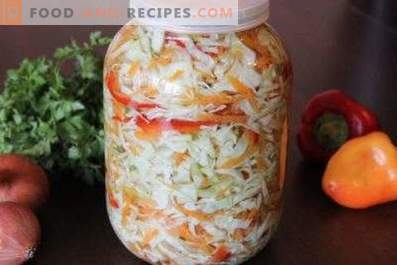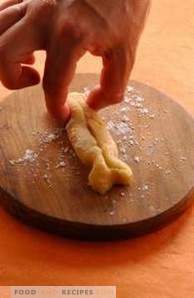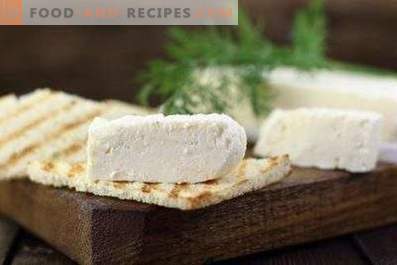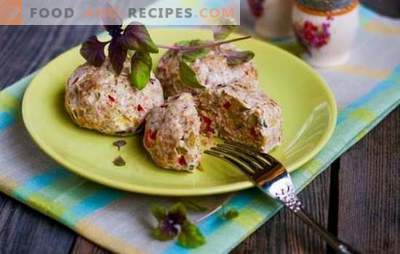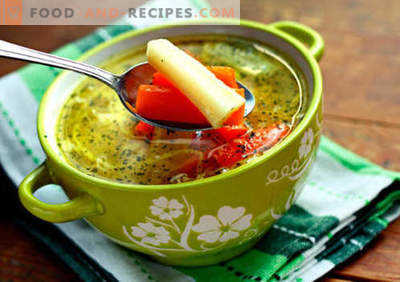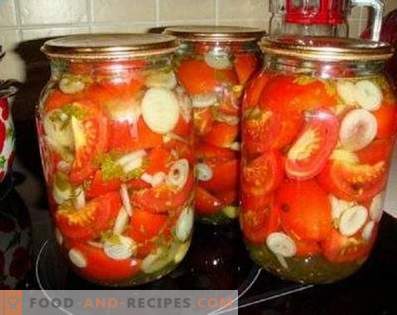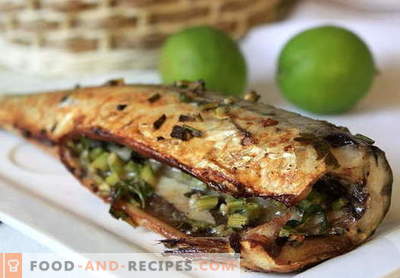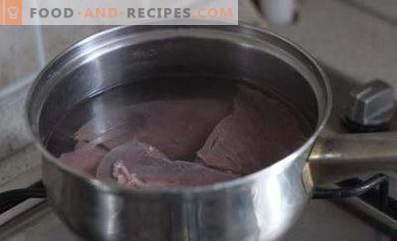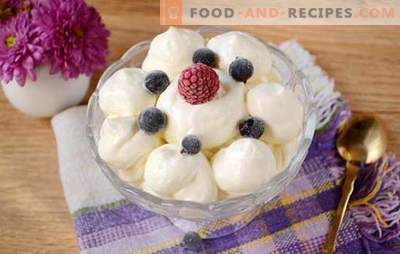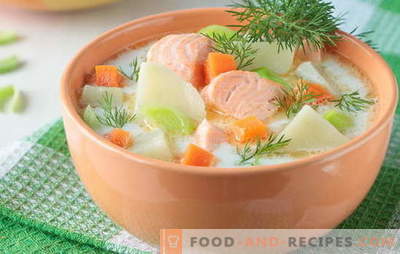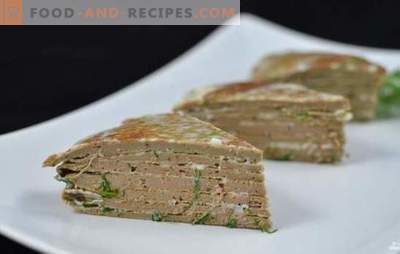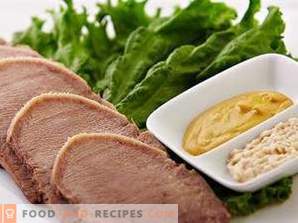
Recently, a video featured on the news was curd burning in a spoon.
This is one of the most "magic" tricks.
After viewing such news, I want to go to the outback to find safe products that do not flare up in a spoon with a blue flame, and after using them you will not have to worry about health.
After all, cottage cheese is a source of calcium, the first natural food for babies.
This product is considered dietary, and therefore it is recommended to use it in the postoperative period, with injuries, to replenish the body's calcium reserves. But when it burns, what kind of health can we talk about?
Refusing a tasty and healthy product is not an option, so we are looking for and find the opportunity to purchase real milk to make homemade curd from sour milk, and from it cheesecakes, casseroles, delicious desserts, stuffing for pies, dumplings - everything that the soul desires, at the same time, without fear for well-being.
Cottage cheese from sour milk - the basic technological principles
Making curd yourself is not at all difficult. If there is a firm intention to eat natural and environmentally friendly products, you need to solve the first two tasks: where to buy raw materials, that is, milk, and to prepare materials and equipment that may be needed to produce cottage cheese from sour milk.
About milk, as the main raw material for cottage cheese from sour milk
Of course, cottage cheese can also be obtained from milk, which is sold in bags, provided that it is natural, and not reconstituted from dry powder, with a shelf life of not more than 36 hours. You can even get cottage cheese from pasteurized milk by adding rennet and calcium chloride to it, at least to “revitalize” it a little and return the calcium ions that are lost during pasteurization, binding casein (milk protein).
The best raw material for curd is fresh, natural, only from under a cow or a goat, aged no more than 12 hours. It is clear that for urban residents is a luxury. Try to find milk workers who will be happy to deliver milk at the appointed time directly to the house, or discuss on what days it will be possible to meet with them on the market. Immediately agree that you will only buy evening milking milk - it is fatter, by morning in the bottles with such milk there is a very clear line of separation of cream and milk, which can be used to approximately judge the fat content of milk. If you want to get low-fat cottage cheese, the cream can be removed and cook sour cream or butter out of them, or you can use it for other culinary purposes. Good homemade milk is when it can be seen that cream takes up 1/3 of the volume of the bottle, that is, three liters of milk contain about 30% cream, therefore about 10% are in one liter. But this is only the fattest, visible part, and in fact, the fat content of cow's milk can reach 50-55%. After removing the cream from the surface of the bottle, do not think that there is skimmed milk left in the container. It just got a little smaller. If it is necessary to get a fat-free spit, then one cannot do without a separator. But about him - a little later. Goat milk is less fat, its biochemical composition is more in line with the enzymes of the human body that are involved in the process of digesting and assimilating milk. Therefore, if it is possible to find natural goat's milk, then do not give up the opportunity to make curd from it, especially since you can make Ricotta, Chevre and other delicacies from such curd.
Goat milk is a very useful product containing natural antibiotics. It is recommended for children with artificial feeding, based on it milk formulas are prepared. The only difficulty is the specific smell of the product, which often occurs with improper care of the animal. So, when buying a goat milk, smell it, do not hesitate.
What is needed for a home cheese factory?
It is already no secret to anyone that before the Peter the Great, cottage cheese was called cheese, because it was obtained in the raw way. But even for such a method of making homemade cottage cheese from sour milk, some materials and devices will be needed.
Planning to make cottage cheese from skim or goat milk? Then you need to stock up on milk sourdough and calcium chloride. Universal starter - pepsin. For more creamy and delicate taste - lipase. Finding special rennet enzymes for making dairy products is not a problem, there are specialty shops for this. True, the cost of one gram of lactobacillus is sometimes surprising. The second purchase option is a pharmacy, but in this case, each time it is necessary to independently calculate the rate, because the prescription for pharmaceutical preparations is somewhat different.
For the separation of milk fat and home-made cottage cheese from skimmed milk, one cannot do without special equipment. Here you will need a separator - cream separator. The question of its acquisition must be addressed in a comprehensive manner, along with the question of profitability. Of course, if you want to make the curd yourself only once, then you should not clutter up the kitchen with useless and expensive equipment. But in principle, the separator is a useful thing, at least, because it greatly facilitates the work of separating the cream and allows you to get a more accurate and high-quality result. If you decide that the acquisition of such technology is not necessary, then the cream from the surface of milk is easiest to remove, using the principle of communicating vessels. This experience in physics lesson at school is surely remembered by many. We take the second can and place it below the level of the can of milk in which cream floats on the surface. We put a tube into each container (in a jar of milk, it must touch the bottom), create a vacuum inside it, and the milk flows into the empty dishes below. As soon as the cream remains in the upper bowl, take out the tube. Then each of the products is processed separately.
If you leave the milk as it is, then making cottage cheese from sour milk will not be difficult at all: to ferment it, the product contains everything you need, and therefore, apart from suitable dishes and gauze napkins, nothing will be needed to separate the whey. In this way, cottage cheese is prepared for centuries.
What amount of dishes to choose is decided on the basis of the required amount of the finished product. A kilogram of cottage cheese requires 10 liters of whole cow milk, 12 liters of skimmed cow milk, and up to 14 liters of goat milk. Dishes should not be oxidized. If you decide that the milk should be pasteurized, then, in addition to the volume, you need to pay attention to the presence of non-stick coating. In the process of making cottage cheese there is a by-product - whey. For her, you also need to prepare sterile jars, because, despite the technological rules, whey is considered a waste of production, it still remains a valuable food product. It can be added to the dough, instead of water, and the dough will only benefit from it. Serum can be cooked okroshka, if there is no kvass, and such okroshka can be given to children.
The main stages of cooking cottage cheese
Actually, having understood all the preparatory moments, it remains to get acquainted with the algorithm of direct cooking homemade curd from sour milk. This order is simple.
Fermentation of milk
This process takes place when the raw material is heated to 30-35 o C. Rennet is added to fresh milk. Protein coagulation occurs. Within 5-6 hours a tight clot forms, which is cut into smaller pieces with a knife or string to speed up the separation of serum. It should be borne in mind that when making enzymes in fresh milk, the weight of the curd increases, as the separation of whey occurs more efficiently and quickly than when fermenting milk in a natural way.
Without the addition of rennet enzymes and calcium chloride to pasteurized milk, the volume of the finished cottage cheese is significantly reduced, and the curd is dry and fine-grained.
Serum separation
A tight clot formed after souring is collected by a slotted spoon from a pan and transferred to a colander for further serum flow. When receiving dry and fine grains, the colander must be replaced with a sieve or the surface should be lined with an additional gauze cloth. Next you need to install a sieve on the pallet and allow the serum to drain. After 3-4 hours, the finished cottage cheese, depending on its consistency and humidity, is put into sterile containers or bags and stored in the refrigerator or used for culinary purposes.
Recipe 1. Cottage cheese from sour milk, whole
Raw material:
- Farmers cow milk 5.5 l
- Lemon juice 100 ml
- Output: 0.5 kg
Cooking Technology:
Pour fresh, non-pasteurized milk into a saucepan and heat to 35-38 ° C. When heated, it is desirable to constantly stir the milk to ensure the same heating temperature. Do not interrupt the stirring, pour in lemon juice. The milk should curl up. Turn off the stove and leave a clot until fully sealed. Then cut it into squares with a knife and put it in a colander. After 3 hours, cottage cheese will be ready. It can be used in this form, but if you continue the cooking process and, wrapping the product in cheesecloth, put it under the yoke, then the next day you will get Paneer - a popular Indian cheese.
Recipe 2. Home-made cottage cheese from sour milk, fresh nonfat
Raw material:
- Cow's milk, shot 12.0 l
- Lipase 2.4 mg
- Calcium Chloride 1.5 mg
Cooking Technology:
Separated milk (reverse), pour cream into a large saucepan without cream, heat over low heat to 35 ° C. Dissolve the rennet and calcium chloride in 50 ml of warm milk or water, pour them into the heated milk and continue to warm it up before coagulation begins, stirring gently. Turn off the heat and wait for a tight clot to form. Cut it and remove it from the surface of the whey into a prepared colander (cover it with gauze and place on a pan). After compaction of the curd mass, transfer the finished curd to the container.
Recipe 3. Home-made curd made from sour milk, whole pasteurized
Raw material:
- Milk (10%), cow 10 l
- Calcium Chloride 2.0 mg
- Pepsin 1.5 mg
Cooking Technology:
If you pasteurize the milk yourself, at home, it must be heated for 7-10 minutes, to a temperature of 85-90 ° C, but do not allow the milk to boil. After pasteurization, cool to 35 ° C and then proceed according to the technology described in recipe No. 2. If chilled pasteurized milk is used to make cottage cheese, on the contrary, it is necessary to preheat it beforehand, before making the sourdough.
Recipe 4. Home made cottage cheese from sour milk - how to make cottage cheese from yogurt?
Raw material:
- Homemade yogurt 6 l
- Milk is fresher 4 l
- Rennet 2.0 mg
Cooking Technology:
Pour fresh milk into a saucepan (12 l), put on low heat and heat, gradually pouring yogurt, carefully stir it before, to break the clots. Add the solution of the prepared starter. Keeping the milk mixture at a temperature of 35 ° C, turn off the stove after 10 minutes. After cooling, cut and collect the clot, transfer it into a container prepared for straining.
Recipe 5. Home-made cottage cheese from sour milk, goat
Raw material:
- Whole milk 3 l
- Lipase 1.0 mg (or serum - 150 ml)
- Calcium Chloride 1.2 mg
Technology:
Pour the milk into the pot (3.5-4.0 liters). Add to it the serum remaining from the previous preparation of cottage cheese or dilute calcium chloride and lipase in warm water separately. Add to milk and put it for a day in a warm place for ripening. The next day, place a pot of water on the stove. To do this, cook a pan of larger volume than a container of milk. Heat the sour milk on the water bath until the whey rises to the surface (it has a greenish tint). In goat's milk, the milk clot settles to the bottom, unlike cow's, due to the peculiarities of the protein structure. Turn off the stove and allow the future curd to cool naturally.
To separate the whey, prepare a sieve or double gauze, as goat milk cheese grain is smaller and softer. Pour the contents of the pan into the prepared filter placed on the pan. Adjust the moisture content of the curd at its own discretion, leaving the right amount of whey in the curd.
Recipe 6. Home made sour milk curd cheese - an unusual recipe
Raw material:
- Whole milk, homemade 3.0 l
- Sour milk 2 l
Cooking:
Pour milk into heat-resistant dishes and pasteurize it without covering it. When a film forms on the surface, put the pan in the oven preheated to 85-90 ° C and hold until golden brown. Turn off the oven and remove the pan when it cools to 40 ° C. Carefully remove the crust and add the yogurt to the baked milk. Leave the mixture for a day. After that, put on the stove and warm at 30 ° C for fifteen minutes. Cool again and pour into a prepared sieve.
The cottage cheese will have a pleasant taste of baked milk.
Homemade cottage cheese from sour milk - tips and tricks
- After cooking the curd, leave a part of the whey for the next time: this way you can save on the purchase of starter cultures and enzymes.
- Of course, you can wait for the milk to turn sour, naturally, but the cottage cheese as a result of such ripening is worse in taste. In addition, the longer the milk turns sour, the more likely it is that undesirable microorganisms enter it, which can spoil not only the taste of the curd, but also harm the health.
